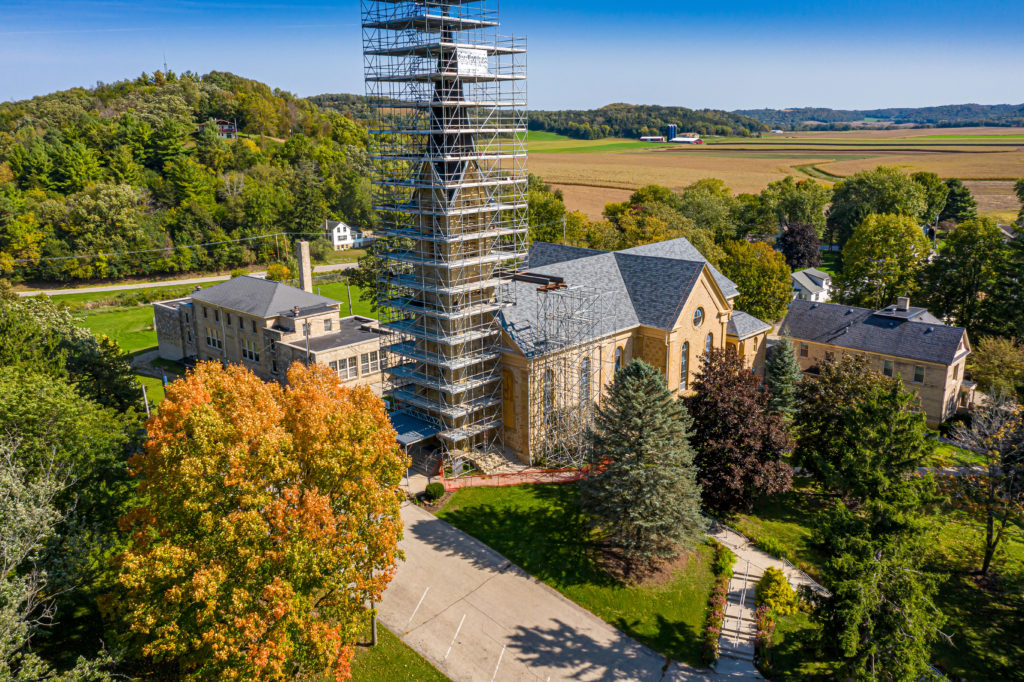
Substantial Masonry Restoration Effort
St. Norbert’s Catholic Church engaged BEPG in 2017 to complete a building envelope assessment of the entire church. Amongst other concerns, the church reported that they had been experiencing masonry falling from the tower, leading to life-safety fears for parishioners entering the church. BEPG quickly moved to have a protective canopy installed at the primary entrance. BEPG’s inspection revealed severe deterioration of the stone and mortar, necessitating a substantial masonry restoration effort.
On Monday, October 9th, 2020, the scaffolding came down from St. Norbert’s Catholic Church after completely enclosing the tower and spire for five months. Disassembly marks the completion of an extensive restoration effort by masons, sheet metal workers, roofers, and window restoration specialists to stabilize and restore the 130-year-old tower and ensure its preservation for another century.

Construction History
Quarried from a nearby quarry in the hills surrounding Roxbury, the stone used for both the 1860s church building and 1890s tower is a tan and orange-hued limestone with lots of color and texture differentiation, giving the church an incredibly unique visual character. Many of the masonry buildings in the immediate and surrounding areas use the same limestone.
Masonry Restoration Considerations
BEPG’s primary goal for the church’s restoration was to preserve the building’s original character, including keeping as much of the original stone in place as possible. The masonry contractor and our staff thoroughly surveyed the entire tower to determine the extent of stone restoration needed.

Matching the existing stone
Finding a good match for the stone was difficult. First, the original stone is texturally complex. In addition, the original masons built the church with both textured and smooth cuts of stone. Secondly, the original quarry closed decades ago, and no local quarries provided similar limestone. With the help of the masonry subcontractor, BEPG found an excellent match at a Milwaukee supplier, who supplied all the replacement stone for the rehabilitation work.
Where necessary, stones were removed and replaced with a stone tooled to fit with the surrounding masonry as seamlessly as possible.
Stabilizing salvageable stone
To salvage and repair deteriorated stones, the mason removed the loose stone and applied a potassium-silicate stone consolidant. This waterborne treatment saturates and reacts with the limestone, producing a strong but invisible crystalline bond. This process provides structural stability to minor delaminations and pores in the stone without damaging or changing the visual character of the stone.

Identifying and matching mortar
Identifying a suitable mortar was just as important as finding a matching stone. The original white-colored mortar is now tinged with tan due to leaching from the limestone. Additionally, over 150-plus years, many pointing repair efforts had been undertaken, using unsympathetic mortar colors and compositions. Mortar samples were taken from the building and sent to an independent petrographic lab for analysis. The lab returned recommendations for the composition of the replacement mortar, including a primarily lime-based mixture rather than the common portland cement mortars used in modern masonry work. Using an overly hard mortar (such as a Type O mortar) to repoint the building would eventually lead to accelerated deterioration of the limestone. Based on these recommendations, BEPG specified a Pozzolan Hydraulic Lime (PHL) repointing mortar, with aggregate mixture and sizing to compliment the stone’s color.
Additional restoration measures
BEPG is thrilled with the masonry restoration work at St. Norbert’s Church. In addition to masonry work, the tower restoration included structural repairs and stabilization, full slate re-roofing, and stainless steel trim.
BEPG has years of experience working with historical buildings. Check out other restoration projects or contact us.
